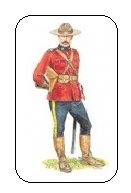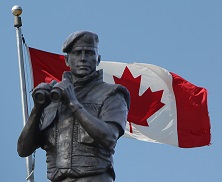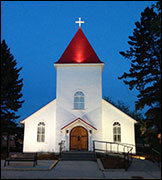True and Fascinating Canadian History
The Mystery of a Mountie's Grave
Which Required Minimal Maintenance
by Toronto Vet Jack O'Reilly
& J. J. Healy
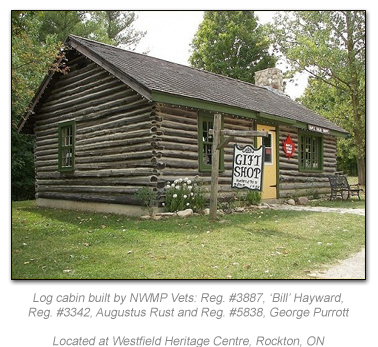
Research on the early years of the Force has established a well known but surprising fact -- which is, that several members of the North West Mounted Police (NWMP) were engaged for duty without their true identity having been solidly established by recruiters. Little could be done. The Force required time to get a foothold on it's administrative procedures.
The NWMP was not the only organization to suffer false friends. From the beginning of time, conspirators for one side gained valuable intelligence of warfare strategies by faking their true identity. In the NWMP, a certain but small percentage of NWMP recruits followed a time honoured ritual common among other like minded men. The goal was to falisfy their origins, employment or background. Fake it and hope not to be caught.
Let's face it, every man will admit that there are valid reasons to skip town. Quickly. Consider the consequences of bank robbery or horse stealing. One did not laze about for a misguided pronouncement. Rope was in abundance. Some men were criminals who concluded there was little chance to be identified while employed inside the NWMP. I mean who's going to be curiously looking at a talented bugler who made it to Corporal or even an efficient Sergeant grooming the Commissioner's horse?
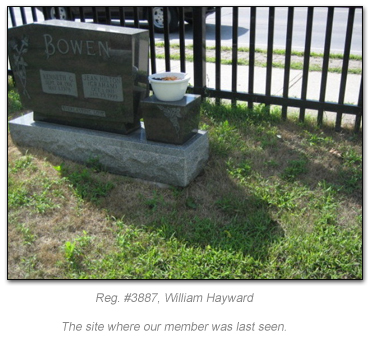
The entanglement by men of taking too many lovers gave need to the navy -- a sure and safe haven which would sweep men away on voyages which guaranteed they would be missing for several years. Not unlike mushing one's horse towards Western Canada -- a long March which never seemed to end. The NWMP and the navy gave one sufficient time to catch one's breath. It had everything to do with disguise.
The theory of man's anonymity presented so far is not too far fetched. However, nothing has been said thus far about a very different and unique way of a NWMP member to disappear. At death time, everyone prefers to try something original. Let's just say that Toronto Vet Jack O'Reilly stumbled upon a rare case of a member who disappeared under one's nose. Jack's file is appropiately named 'The Mystery of a Mountie's Grave which Required Minimal Maintenance'. Jack's Mystery began this way.
Reg.#3887, NWMP Constable William 'Bill' Hayward joined the Force in 1902. A photographer by profession, Hayward was a native of Ontario. He came off the farm. It's known that Bill Hayward was posted to Dawson -- loyal and dependable men were in need in the north due to the Gold Rush. However, after four years of police activity in Dawson, Bill Hayward 'Purchased his Discharge' for an undisclosed sum of money. Bill was Force free. He returned to his farm in Ontario. All was well. He had photography to fall back on.
As the years passed by, Bill Hayward remained close with his contemporaries in the Force. In 1935, Bill Hayward, Reg.#3342, Augustus Rust and Reg.#5838 George Purrott built a replica of the log cabins once used by the NWMP in western Canada. At one time, the log cabin was located at the corner of Queenston Road and Parkdale Ave in Hamilton, Ontario. It was used as an Information Bureau and as a club house for the Hamilton area RNWMP Veteran's Association.
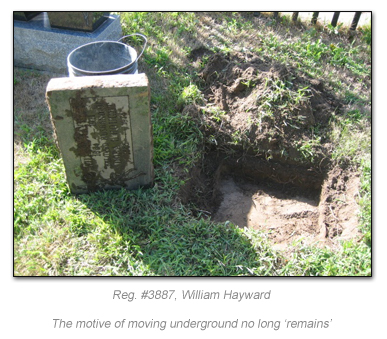
There came a time when the cabin had to be moved. Today, it stands at the Westfield Heritage Centre in Rockton, ON, which is west of Hamilton. London Vet Bill Helland took an interest in the cabin and wrote an article on the log cabin for the October 1969 Quarterly.
Years ago, Toronto Vet Jack O'Reilly eagerly began to lead a team of Vet Volunteers to track grave sites of deceased members in the wide Toronto area. Jack said that 'ole timer William 'Bill' Hayward was known to have lived in the Milton Centennial Manor in 1971. By this time, Constable Hayward was 87 years young. However, Jack also discovered that the Milton Manor had been replaced by the Aldergrove Manor. Sadly, no records of former residents had been retained by administrators.
Jack continued: 'After working on Hayward's file off and on for the past three years or so, I finally confirmed that Reg.#3887 Hayward was buried in St. Matthew's Anglican Church Cemetery, Burlington, ON. Church records were not very complete but they did show Hayward's age as 87 years. He died at Milton, ON in 1971'.
Vet Jack O'Reilly also said that in 1971 Toronto Vets had been informed that Bill Hayward knew that he was suffering poor health and his time was limited. In 1971, he was living at the Halton Centennial Manor in Milton, ON. Bill expressed the thought that he wasn’t going to last long. He was right, as he passed away sometime between April and December, 1971.
Still, Jack O'Reilly could not find Bill's obituary which made his burial place more difficult to find. In the meantime, Jack had confirmed that Bill's wife Dora died in 1974 and then the two were buried together. Throughout his search for Bill Hayward, Jack also could not find a Hayward headstone.
Jack considered this a minor glitch and pursued his goal to find Bill Hayward's grave. Yet, the biggest challenge in regards to Bill Hayward still faced investigator Jack O'Reilly. He posed that Bill's grave could not be recorded, photographed and maintained properly if it could not be located.
A big, unexpected break-through for Jack came in October, 2011.
Jack exclaimed: 'We can remove Reg.#3887 Hayward from our list of unmarked graves -- 'Bill Hayward was hiding underground but he has been found'!.
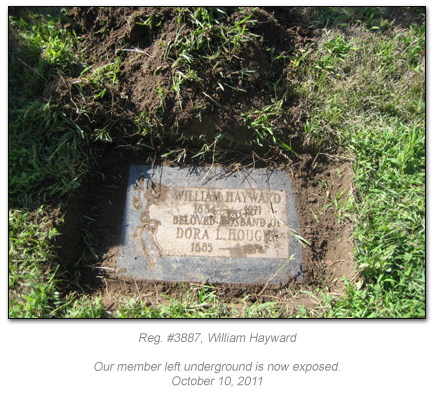
Jack was finally able to clean up the Hayward Grave Mystery. Jack said: 'When I located his grave at St Matthew's Cemetery in Burlington back in March 2011, there was still a bit of snow around and the ground was still frozen.
I searched and there certainly was no evidence of a Hayward grave marker in the St. Matthew's Cemetery. Further, St. Matthew's had no record of the marker. The absence of solid evidence led me to list William Hayward's grave as unlisted. It was not able to be located'. A mystery by miles.
Jack explained: 'I was driving past St. Matthew's recently and I decided to stop at the cemetery and get a photo of the area where Hayward is supposed to be buried. I poked around in the ground. Poke, poke, poke. I hit something solid about 5 inches down. I decided to dig a little deeper.
Whoa, Faux Pas!
Finally a hit! It was as rare as a hole in one. But, the pictures included in this mystery story will show what I found.
There was no one at the cemetery so after uncovering the stone, I had a big pile of dirt and didn’t know where to put it.
I decided to put it back in the hole, so I lifted the marker, filled the hole with the dirt then placed the marker level with the ground. Clean and readable too.
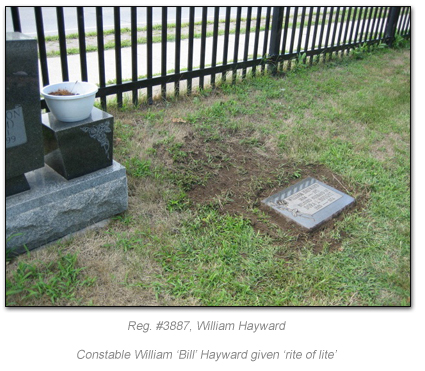
The marker looks like new as it had not been exposed to the weather for a few years.
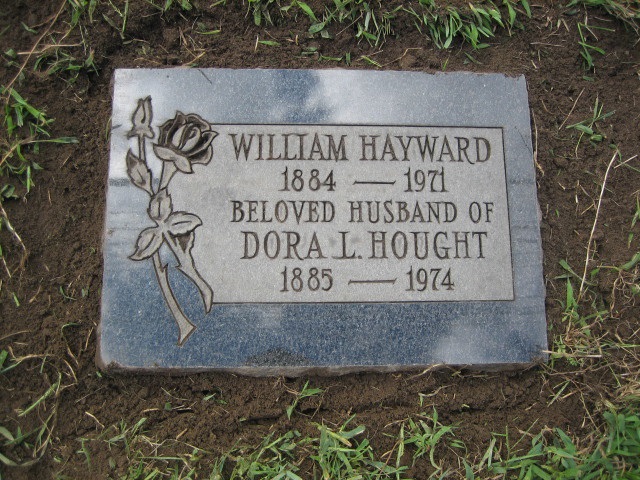
In summary, men may disappear and go underground for all kinds of reasons. It's their business. But, William 'Bill' Hayward of the NWMP was not of that sort. He had nothing to hide and nothing to run from.
Bill Hayward did not disappear intentionally. To slip underground was not his intention. But, we known that weather can affect property of all kinds in a cemetery. Bill Hayward deserved to be found. He relied and depended on our Toronto Vets and Jack O'Reilly to break the case open. Successfully.
The principle attribute of an investigator is persistence. The outcome of this file proved it!
All our thanks, respect and appreciation go out to Toronto and Jack O'Reilly.
Job very, very well done! Thank you
Reporting From the Fort
J. J. Healy
January 26, 2012
